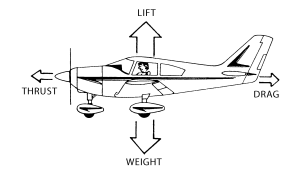The four forces of flight make up the fundamental concept of flight. Lift, weight, thrust, and drag are the very first concepts students learn in ground school. In this post, we’ll give you an introduction to the first two: Lift and Weight. The Student Pilot’s Flight Manual by William Kershner explains this well:
Lift
Lift is a force exerted by the wings. (Lift may also be exerted by the fuselage or other component, but at this point, it would be best just to discuss the major source of the airplane’s lift, the wings.) It is a force created by the “airfoil,” the cross-sectional shape of the wing being moved through the air or, as in a wind tunnel, the air being moved past the wing. The result is the same in both cases. The “relative wind” (wind moving in relation to the wing and airplane) is a big factor in producing lift, although not the only one.
Lift is always considered to be acting perpendicularly both to the wingspan and to the relative wind. The reason for this consideration will be shown later as you are introduced to various maneuvers. As the wing moves through the air, either in gliding or powered flight, lift is produced. How lift is produced can probably be explained most simply by Bernoulli’s theorem, which briefly puts it this way: “The faster a fluid moves past an object, the less sidewise pressure is exerted on the body by the fluid.” The fluid in this case is air; the body is an airfoil.
The distance that the air must travel over the top is greater than that of the bottom. As the air moves over this greater distance, it speeds up in an apparent attempt to reestablish equilibrium at the rear (trailing edge) of the airfoil. (Don’t worry, equilibrium won’t be reestablished. ) Because of this extra speed, the air exerts less sidewise pressure on the top surface of the airfoil than on the bottom, and lift is produced. The pressure on the bottom is normally increased also and you can think that, as an average, this contributes about 25 percent of the lift; this percentage varies with “angle of attack.”
Weight
Gravity is like the common cold, always around and not much that can be done about it. This can be said, however: Gravity always acts “downward” (toward the center of the earth). Lift does not always act opposite to weight.
Stay tuned for introductions to the other two forces, thrust and drag, in the next post. You can purchase The Student Pilot’s Flight Manual on our website at ASA2Fly.com, which also contains even more resources for student pilots.
Have a safe journey!





